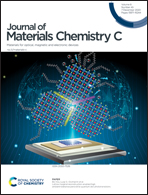Stimuli-responsive luminescent bithiophene-dicarbaldehyde molecular rotors by hydrogen bonding†
Abstract
The strategy of controlling the rotation of molecular rotors by hydrogen bonding in the excited state to construct stimuli-responsive luminescent materials (SRLMs) has been proposed. Two bithiophene-dicarbaldehyde rotors, 2T3C and 2T5C, are synthesized to confirm this strategy. The conformational changes of the bithiophene-dicarbaldehyde rotors in the excited state are discussed through experiments and theoretical calculations. The rotational barrier of 2T3C can be overcome by intermolecular hydrogen bonding, which makes the conformation in the excited state makes to tend to a coplanar conformation. Obvious responses of 2T3C to hydrogen bond donors can be observed in both solid and solution states. After being ground with silica gel in the solid state, the fluorescence changes from a white dark state to a green bright state. Based on the above principle, a smart erasable writing film responding reversibly to the stimulation of water is prepared by doping 2T3C into a PVP polymer matrix.



 Please wait while we load your content...
Please wait while we load your content...